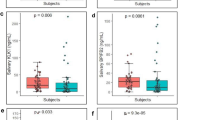Abstract
Since oral squamous cell carcinoma (OSCC) is one of the most important causes of death worldwide, the prevention and early detection plays a crucial role. Recent epidemiological studies have incriminated diabetes as a risk factor for the development of OSCC, as well as oral premalignant lesions. As for the last 20 years diabetes and oral squamous cell carcinoma rates have been increasing rapidly, therefore a reliable detection method of major saliva proteins as possible biomarkers for OSCC is of key priority. In this study we collected whole saliva samples from patients with diabetes and from healthy subjects. To reduce the risk of failure and to keep the investigation good reproducible, we proposed an examination and saliva collecting technique. The proteins were analyzed using SDS-PAGE and MALDI TOF/TOF mass spectrometry. Our findings show that the expression of Annexin A8, Peroxiredoxin-2 and Tyrosine kinase is elevated by patients having diabetes. All these proteins have been previously described in cancer saliva samples also in OSCC. Our current findings showed that testing saliva may be an effective and reliable method for detecting oral cancer in early stages.
Similar content being viewed by others
References
Wong DT (2006) Salivary diagnostics powered by nanotechnologies, proteomics and genomics. J Am Dent Ass 137:313–321
Segal A, Wong DT (2008) Salivary diagnostics: enhancing disease detection and making medicine better. Eur J Dent Educ 12(suppl):22S–29S
Szanto I, Mark L, Bona A, Maasz G, Sandor B, Gelencser G, Turi Z, Gallyas F Jr (2012) High-throughput screening of saliva for early detection of oral cancer: a pilot study. Technol Cancer Res Treat 11(2):181–188
Jarai T, Maasz G, Burian A, Bona A, Jambor E, Gerlinger I, Mark L (2012) Mass spectrometry-based salivary proteomics for the discovery of head and neck squamous cell carcinoma. Pathol Oncol Res 18(3):623–628
Parkin DM, Bray F, Ferlay J, Pisani P (2005) Global cancer statistics, 2002. CA Cancer J Clin 55:74–108
Argiris A, Karamouzis MV, Raben D et al (2008) Head and neck cancer. Lancet 371:1695–1709
Decker J, Glodstein JC (1982) Risk factors in head and neck cancer. N Engl J Med 306:1151–1155
Hintao J, Teanpaisan R, Chongsuvivatwong V et al (2007) The microbiological profiles of saliva, supragingival and subgingival plaque and dental caries in adults with and without type 2 diabetes mellitus. Oral Microbiol Immunol 22:175–181
Lamster IB, Lalla E, Borgnakke WS, Taylor GW (2008) The relationship between oral health and diabetes mellitus. J Am Dent Ass 139:19S–24S
American Academy of Periodontology (1996) Position paper: diabetes and periodontal diseases. J Periodontol 67:166–176
Negrato CA, Tarzia O (2010) Buccal alterations in diabetes mellitus. Diabetol Metab Syndr 15:2–3
Lu H, Ouyang W, Huang C (2006) Inflammation, a key event in cancer development. Mol Cancer Res 4(4):221–233
Ujpál M, Matos O, Bídok G, Somogyi A, Szabó G, Suba Z (2004) Diabetes and oral tumors in Hungary. Diabetes Care 27:770–774
Albrecht M, Bánóczy J, Dinya E, Tamás G Jr (1992) Occurence of oral leukoplakia and lichen planus in diabetes mellitus. J Oral Path Med 21:364–365
Navazesh M (1993) Methods for collecting saliva. Ann NY Acad Sci 694:72–77
Laemmli UK (1970) Cleavage of structural proteins during the assembly of the head of bacteriophage T4. Nature 227:680–685
Vairaktaris E (2004) Diabetes and oral oncogenesis. Anticancer Res 27:4185–4194
Farnaes L, Ditzel HJ (2003) Dissecting the cellular functions of annexin XI using recombinant human annexin XI-specific autoantibodies cloned by phage display. J Biol Chem 278(35):33120–33126
Tomas A, Futter C, Moss SE (2004) Annexin 11 is required for midbody formation and completion of the terminal phase of cytokinesis. J Cell Biol 165(6):813–822
Rand JH (2000) The annexinopathies: a new category of diseases. Biochim Biophys Acta 1498:169–173
Paweletz CP, Ornstein DK, Roth MJ, Bichsel VE, Gillespie JW, Calvert VS, Vocke CD, Hewitt SM, Duray PH, Herring J, Wang QH, Hu N, Linehan WM, Taylor PR, Liotta LA, Emmert-Buck MR, Petricoin EF (2000) Loss of annexin 1 correlates with early onset of tumorigenesis in esophageal and prostate carcinoma. Cancer Res 60:6293–6297
Wood ZA, Poole LB, Karplus PA (2003) Peroxiredoxin evolution and the regulation of hydrogen peroxide signaling. Science 300:650–653
Lu Y, Liu J, Chengzhao L, Wang H, Jiang Y, Wang Y, Yang P, He F (2010) Peroxiredoxin 2: a potential biomarker for early diagnosis of Hepatitis B Virus related liver fibrosis identified by proteomic analysis of the plasma. BMC Gastroenterol 10:115
Hanks SK, Quinn AM, Hunter T (1998) The protein kinase family: conserved features and deduced phylogeny of the catalytic domains. Science 241(4861):42–52
Weinberg RA (2007) The biology of cancer. New York: Garland Science, Taylor & Francis Group, LLC. pp 757–759
Acknowledgments
This study was supported by the Hungarian National Scientific Research Foundation (OTKA Grant No. K72592, D048294, PD 78599), TIOP 1.3.1-10/1-2010-0008, TIOP 1.3.1-07/1, TÁMOP-4.2.2.A-11/1/KONV-2012-0053, DDEK Kft, SciEx Kft. and PTE AOK KA 2009, 2011 and 2013.
Author information
Authors and Affiliations
Corresponding author
Rights and permissions
About this article
Cite this article
Jancsik, V.A., Gelencser, G., Maasz, G. et al. Salivary Proteomic Analysis of Diabetic Patients for Possible Oral Squamous Cell Carcinoma Biomarkers. Pathol. Oncol. Res. 20, 591–595 (2014). https://doi.org/10.1007/s12253-013-9736-8
Received:
Accepted:
Published:
Issue Date:
DOI: https://doi.org/10.1007/s12253-013-9736-8




